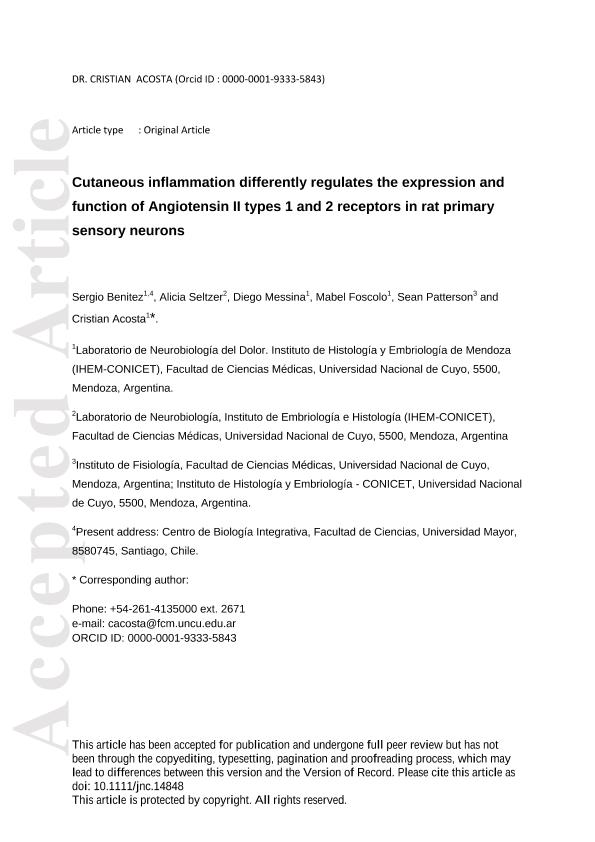Artículo
Cutaneous inflammation differentially regulates the expression and function of Angiotensin-II types 1 and 2 receptors in rat primary sensory neurons
Benitez, Sergio Gonzalo ; Seltzer, Alicia Mabel
; Seltzer, Alicia Mabel ; Messina, Diego
; Messina, Diego ; Foscolo, Mabel Rosa
; Foscolo, Mabel Rosa ; Patterson, Sean Ingram
; Patterson, Sean Ingram ; Acosta, Cristian Gabriel
; Acosta, Cristian Gabriel
 ; Seltzer, Alicia Mabel
; Seltzer, Alicia Mabel ; Messina, Diego
; Messina, Diego ; Foscolo, Mabel Rosa
; Foscolo, Mabel Rosa ; Patterson, Sean Ingram
; Patterson, Sean Ingram ; Acosta, Cristian Gabriel
; Acosta, Cristian Gabriel
Fecha de publicación:
03/2020
Editorial:
Wiley Blackwell Publishing, Inc
Revista:
Journal of Neurochemistry
ISSN:
0022-3042
Idioma:
Inglés
Tipo de recurso:
Artículo publicado
Clasificación temática:
Resumen
Neuropathic and inflammatory pain results from cellular and molecular changes in dorsal root ganglion (DRG) neurons. The type-2 receptor for Angiotensin-II (AT2R) has been involved in this type of pain. However, the underlying mechanisms are poorly understood, including the role of the type-1 receptor for Angiotensin-II (AT1R). Here, we used a combination of immunohistochemistry and immunocytochemistry, RT-PCR and in vitro and in vivo pharmacological manipulation to examine how cutaneous inflammation affected the expression of AT1R and AT2R in subpopulations of rat DRG neurons and studied their impact on inflammation-induced neuritogenesis. We demonstrated that AT2R-neurons express C- or A-neuron markers, primarily IB4, trkA, and substance-P. AT1R expression was highest in small neurons and co-localized significantly with AT2R. In vitro, an inflammatory soup caused significant elevation of AT2R mRNA, whereas AT1R mRNA levels remained unchanged. In vivo, we found a unique pattern of change in the expression of AT1R and AT2R after cutaneous inflammation. AT2R increased in small neurons at 1 day and in medium size neurons at 4 days. Interestingly, cutaneous inflammation increased AT1R levels only in large neurons at 4 days. We found that in vitro and in vivo AT1R and AT2R acted co-operatively to regulate DRG neurite outgrowth. In vivo, AT2R inhibition impacted more on non-peptidergic C-neurons neuritogenesis, whereas AT1R blockade affected primarily peptidergic nerve terminals. Thus, cutaneous-induced inflammation regulated AT1R and AT2R expression and function in different DRG neuronal subpopulations at different times. These findings must be considered when targeting AT1R and AT2R to treat chronic inflammatory pain. (Figure presented.).
Archivos asociados
Licencia
Identificadores
Colecciones
Articulos(IHEM)
Articulos de INST. HISTOLOGIA Y EMBRIOLOGIA DE MEND DR.M.BURGOS
Articulos de INST. HISTOLOGIA Y EMBRIOLOGIA DE MEND DR.M.BURGOS
Citación
Benitez, Sergio Gonzalo; Seltzer, Alicia Mabel; Messina, Diego; Foscolo, Mabel Rosa; Patterson, Sean Ingram; et al.; Cutaneous inflammation differentially regulates the expression and function of Angiotensin-II types 1 and 2 receptors in rat primary sensory neurons; Wiley Blackwell Publishing, Inc; Journal of Neurochemistry; 152; 6; 3-2020; 675-696
Compartir
Altmétricas



